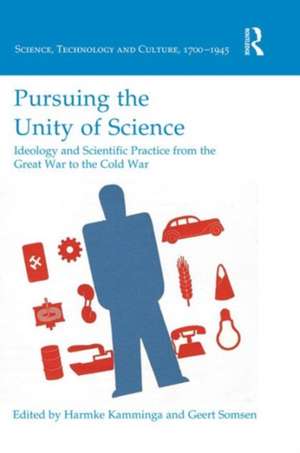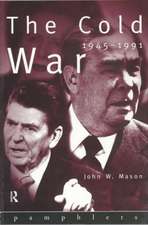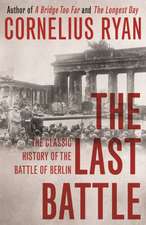Pursuing the Unity of Science: Ideology and Scientific Practice from the Great War to the Cold War: Science, Technology and Culture, 1700-1945
Editat de Harmke Kamminga, Geert Somsenen Limba Engleză Hardback – 27 mai 2016
Din seria Science, Technology and Culture, 1700-1945
-
 Preț: 310.88 lei
Preț: 310.88 lei -
 Preț: 469.34 lei
Preț: 469.34 lei -
 Preț: 469.34 lei
Preț: 469.34 lei - 12%
 Preț: 299.52 lei
Preț: 299.52 lei -
 Preț: 469.34 lei
Preț: 469.34 lei -
 Preț: 469.34 lei
Preț: 469.34 lei -
 Preț: 489.26 lei
Preț: 489.26 lei -
 Preț: 464.12 lei
Preț: 464.12 lei -
 Preț: 489.26 lei
Preț: 489.26 lei -
 Preț: 469.34 lei
Preț: 469.34 lei -
 Preț: 469.34 lei
Preț: 469.34 lei -
 Preț: 486.49 lei
Preț: 486.49 lei -
 Preț: 416.22 lei
Preț: 416.22 lei -
 Preț: 469.34 lei
Preț: 469.34 lei -
 Preț: 469.34 lei
Preț: 469.34 lei - 17%
 Preț: 259.98 lei
Preț: 259.98 lei - 17%
 Preț: 259.98 lei
Preț: 259.98 lei - 12%
 Preț: 299.52 lei
Preț: 299.52 lei - 30%
 Preț: 821.13 lei
Preț: 821.13 lei -
 Preț: 489.26 lei
Preț: 489.26 lei - 20%
 Preț: 250.58 lei
Preț: 250.58 lei - 26%
 Preț: 876.78 lei
Preț: 876.78 lei -
 Preț: 384.66 lei
Preț: 384.66 lei - 16%
 Preț: 261.54 lei
Preț: 261.54 lei - 18%
 Preț: 1001.77 lei
Preț: 1001.77 lei
Preț: 821.13 lei
Preț vechi: 1103.49 lei
-26% Nou
Puncte Express: 1232
Preț estimativ în valută:
157.12€ • 164.49$ • 130.01£
157.12€ • 164.49$ • 130.01£
Carte tipărită la comandă
Livrare economică 05-19 aprilie
Preluare comenzi: 021 569.72.76
Specificații
ISBN-13: 9780754640356
ISBN-10: 0754640353
Pagini: 258
Dimensiuni: 156 x 234 x 20 mm
Greutate: 0.52 kg
Ediția:1
Editura: Taylor & Francis
Colecția Routledge
Seria Science, Technology and Culture, 1700-1945
Locul publicării:Oxford, United Kingdom
ISBN-10: 0754640353
Pagini: 258
Dimensiuni: 156 x 234 x 20 mm
Greutate: 0.52 kg
Ediția:1
Editura: Taylor & Francis
Colecția Routledge
Seria Science, Technology and Culture, 1700-1945
Locul publicării:Oxford, United Kingdom
Cuprins
Contents: Preface; Introduction, Harmke Kamminga and Geert Somsen; Meanings of scientific unity: the law, the orchestra, the pyramid, quilt and ring, Peter Galison; The unifying vision: Julian Huxley, evolutionary humanism and the evolutionary synthesis, Vassiliki Betty Smocovitis; Unity through experiment? Reductionism, rhetoric and the politics of nuclear science, 1918-40, Jeff Hughes; Scientists of the world unite: socialist internationalism and the unity of science, Geert Somsen; Government as scientific process in H.G. Wells’s world state, Rein de Wilde and Geert Somsen; Unifying science against Fascism: neuropsychiatry and medical education in the Spanish Civil War, Fernando Salmón and Rafael Huertas; ’To formulate a plan for better living’: visual communication and scientific planning in Paul Rotha’s documentary films, 1935-1945, Timothy Boon; Unifying science and human culture: the promotion of the history of science by George Sarton and Frans Verdoorn, Bert Theunissen; The unity of knowledge and the diversity of knowers: science as an agent of cultural integration in the United States between the two world wars, David A. Hollinger; McCarthyism in philosophy and the end of the unity of science ideology, George Reisch; Index.
Notă biografică
Harmke Kamminga was a historian of science and medicine, most recently affiliated with the Wellcome Unit for the History of Medicine at the Department of History and Philosophy of Science, University of Cambridge, UK. She was the author of numerous publications on the history of biochemistry, laboratory medicine and origin of life theories. Her books include The Science and Culture of Nutrition, 1840–1940, edited with Andrew Cunningham, Molecularizing Biology and Medicine and Representations of the Double Helix, both edited with Soraya de Chadarevian. Harmke passed away in 2013.
Geert Somsen teaches history of science at Maastricht University and was Marie Curie fellow at Columbia University from 2014 to 2016. His research focuses on science and international relations. Recent publications include Neutrality in Twentieth-Century Europe: Intersections of Science, Culture and Politics after the First World War, edited with Rebecka Lettevall and Sven Widmalm. He is working on a new book, tentatively titled 'Science and World Order’: Uses of Science in Plans for International Government, 1899–1950.
Geert Somsen teaches history of science at Maastricht University and was Marie Curie fellow at Columbia University from 2014 to 2016. His research focuses on science and international relations. Recent publications include Neutrality in Twentieth-Century Europe: Intersections of Science, Culture and Politics after the First World War, edited with Rebecka Lettevall and Sven Widmalm. He is working on a new book, tentatively titled 'Science and World Order’: Uses of Science in Plans for International Government, 1899–1950.
Descriere
This volume explores the unity of science movement, providing a synthetic view of its pursuits and placing it in its historical context as a scientific and political force. Through a coherent set of original case studies that look at the significance of various projects and strategies for unification, the essays demonstrate the great variety of manifestations of this ambitious pursuit. In so doing the book makes visible important historical developments, showing how scientists participated in, and actively helped to create, an interwar ideology of unification and bringing to light the cultural and political significance of this enterprise.












